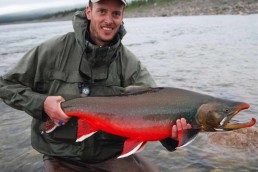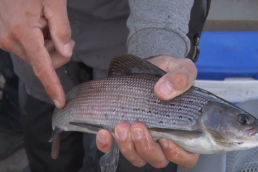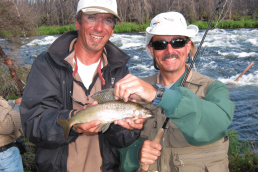Bucket List Arctic Char
SHARE THIS POST
We don’t often write about Arctic char because they live in remote-access locations at the top of the world. Char are cold-water fish that spend much of the early summer running the Arctic coast of Canada, making late-summer spawning runs back up swift, rocky rivers like the Tree and Coppermine Rivers in the Northwest Territories. As such, the few anglers who get to fish for them typically take a daily float plane fly-out from a far-north lodge on, say, Great Bear Lake, across rugged, fog-shrouded mountain ranges, perhaps encountering herds of caribou or muskox across the tundra, or beluga whales along the Arctic coastline.
Upon landing in the river and taxiing ashore, you’ll generally spend the day walking a riverbank, casting from the bank. Some smaller operations in even more remote locales, like the Nanook and Kuujjua Rivers on Victoria Island, may team tent camping with fishing from canoes. Certain inland lakes in Alaska host char as well. In all cases, you’ll have to travel a long way to get there and put a major dent in your checkbook to do it.
Because char are immensely powerful, fast fish typically found in strong current, you’ll need to beef up your tackle and use heavy lures, even though the water will likely be quite shallow where you catch them, filled with boulders, eddies and current breaks. A 7 ½-foot flippin’ stick, collapsible for easy transport, provides the muscle needed to land beasts up to 20 pounds. Heavy spoons like Dardevle Rockets, or weighted spinners like Blue Fox Pixies, are required to run properly in fast current. Hold your rod tip level to the surface, and reel steadily. You don’t have to impart any fancy action to the lure. And when a fish hits, you’ll know it!
The strike is savage, and the following run down current is awesome to behold. You’ll find yourself scrambling along rocky riverbanks, trying to keep up with powerhouse fish racing downstream, your drag screaming in protest. You’ll never land ‘em all, but when you do, you’ll be astounded at their brilliant orange spawning colors—particularly the males. Take a quick photo and enjoy a brief admiration. They release the fish back into its icy home.
Are you enjoying this post?
You can be among the first to get the latest info on where to go, what to use and how to use it!
Fly fishermen may prefer to fish streamers or dry flies on 9-foot, 7- or 8-weight rods; above the tree line, there are no trees to foil your back casts when fishing from shore. But again, the challenge isn’t getting them on—they are eager and willing biters—but rather landing these beasts amidst the roaring waters.
Fishing for char is a true wilderness experience; you’re far off the grid, beyond the borders of civilization, amidst nature at its unspoiled finest. As such, it should be on everyone’s bucket list—something to aspire to on your lifelong angling journey.
Dave Csanda has enjoyed 40 years in the fishing communications industry at In-Fisherman, Angling Edge and now, as editor of MidWest Outdoors. He is an inductee of both the Minnesota and National Fresh Water Fishing Halls of Fame.
MWO
SHARE THIS POST
Did you enjoy this post?
You can be among the first to get the latest info on where to go, what to use and how to use it!
Dave Csanda
Dave Csanda has enjoyed 40 years in the fishing communications industry at In-Fisherman, Angling Edge and now, as editor of MidWest Outdoors. He is an inductee of both the Minnesota and National Fresh Water Fishing Halls of Fame.



